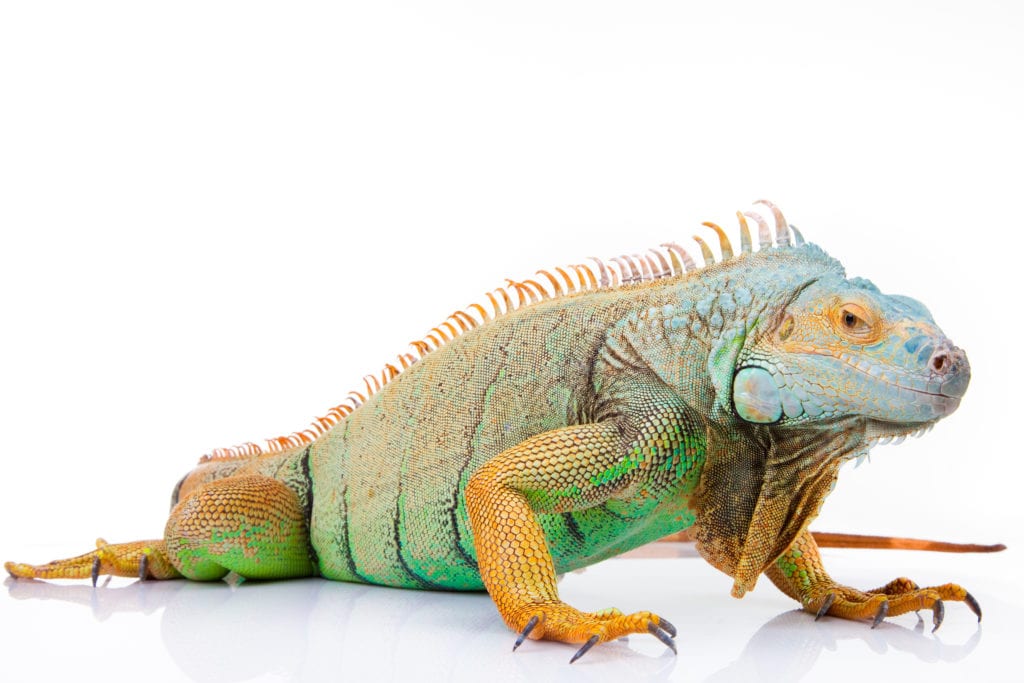Learn How to Take Care of an Iguana, Before Adopting One
Did you know that there are different types of iguanas? There’s the Desert Iguana, Galapagos Land Iguana, and Rhinoceros Iguana – just to name a few. There are some with spiky tails, some that live near the sea, and some that are pink or red in color, but the most popular iguana species that is often kept as a pet is the Green Iguana because they tend to be calm and easy to manage. Green Iguanas derive their name from the very beautiful, vibrant green color of their skin.
When you’re ready to expand your family and bring a scaly friend into your home, there are a few important details to consider to ensure that you are up to speed on proper iguana care and feeding.
5 Important Things to Know When Getting Ready to Take Care of an Iguana:
- Size & Space – Iguanas can grow to be very large, some reaching over 6 feet in length and weighing up to 20 pounds. A large iguana calls for a large iguana habitat and when selecting the appropriate enclosure, it’s important to note that iguanas are arboreal creatures, meaning they often live in trees and have an innate urge to climb. You’ll want to consider this when picking out the perfect iguana tank setup.
- Climate – The Green Iguana is native to South and Central America and some parts of the Caribbean islands. This is because iguanas thrive in tropical weather that is both rich in heat and humidity, so It’s important to provide a warm basking spot and maintain the appropriate humidity level in your iguana tank setup. You can increase humidity by providing a large pool of water or by purchasing a mister and lightly misting the entire habitat, including the iguana, at least twice a day. They are diurnal, which means, like humans, they’re active during the day and sleep at night so your iguana tank setup should have an adjustable climate system with daytime temperatures ranging from 80-90 degrees fahrenheit and nighttime temperatures hovering around 75 degrees Fahrenheit.
- Strength – Iguanas are strong, especially their tails as this is their primary defense system in the wild. Just like any pet, iguanas will need to go through a taming/training period and it’s not uncommon for the handler to experience a tail-whip here and there during this process. It’s all part of the fun in learning how to take care of an iguana.
- Introverts – Iguanas are not very social, nor are they cuddly and they can be a little bit lazy. As they get older, they often enjoy spending their days basking under a heat lamp or in the sunlight completely unbothered. However, if not properly or regularly handled from a young age, iguanas can develop irritable temperaments so while they may not want to go on long walks through the park, a little bit of extra attention each day will go a long way.
- Diet – While some reptiles have been known to indulge in insects, iguanas are natural herbivores, meaning they are at their healthiest when on an all-vegetarian diet. Some great examples of healthy greens include kale, collard greens, beet greens, alfalfa hay, broccoli, cabbage, parsley, and green beans. They can also enjoy fruits like apples, pears, bananas, and more.
Iguanas are ectothermic which means they rely on their environment to regulate their temperature. While this trait makes them a bit more adaptable, they are still sensitive to sudden environmental changes – like moving to Arizona! So, you’ll want to ensure your enclosure is accommodating for a smooth transition to the desert.
Proper iguana care and feeding are crucial to an iguanas lifespan. With the appropriate diet and environment, an iguana can live up to and sometimes beyond 20 years – so, as long as you research as much as you can and consider these factors, you and your iguana are sure to be lifelong friends.
Not intended to be a substitute for professional veterinarian advice, diagnosis, or treatment. Always seek the advice of your veterinarian with any questions you may have regarding the medical condition of your pet. If you think your pet has a medical emergency, call or visit your veterinarian or your local veterinary emergency hospital immediately.


